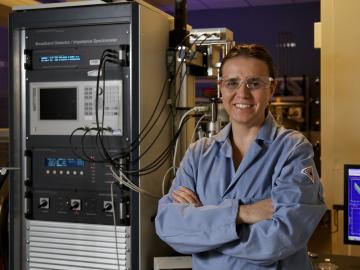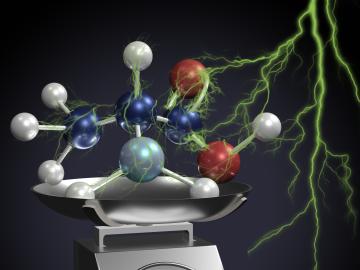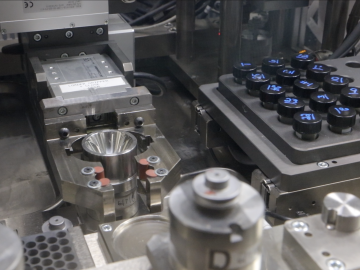
Filter News
Area of Research
- (-) Materials (67)
- (-) Neutron Science (37)
- (-) Nuclear Science and Technology (22)
- Advanced Manufacturing (4)
- Biological Systems (2)
- Biology and Environment (74)
- Computational Biology (2)
- Computational Engineering (2)
- Computer Science (7)
- Electricity and Smart Grid (1)
- Energy Frontier Research Centers (1)
- Energy Science (60)
- Functional Materials for Energy (1)
- Fusion and Fission (12)
- Fusion Energy (7)
- Isotope Development and Production (1)
- Isotopes (10)
- Materials for Computing (11)
- National Security (24)
- Nuclear Systems Modeling, Simulation and Validation (1)
- Quantum information Science (2)
- Sensors and Controls (1)
- Supercomputing (94)
News Topics
- (-) Advanced Reactors (14)
- (-) Artificial Intelligence (12)
- (-) Big Data (3)
- (-) Bioenergy (17)
- (-) Biomedical (21)
- (-) Molten Salt (7)
- (-) Nanotechnology (43)
- (-) Quantum Computing (4)
- (-) Security (3)
- (-) Space Exploration (10)
- 3-D Printing/Advanced Manufacturing (30)
- Biology (11)
- Biotechnology (1)
- Buildings (5)
- Chemical Sciences (34)
- Clean Water (4)
- Composites (9)
- Computer Science (26)
- Coronavirus (14)
- Critical Materials (13)
- Cybersecurity (6)
- Energy Storage (38)
- Environment (21)
- Exascale Computing (2)
- Fossil Energy (1)
- Frontier (4)
- Fusion (16)
- Grid (5)
- High-Performance Computing (6)
- Hydropower (1)
- Irradiation (1)
- Isotopes (16)
- ITER (1)
- Machine Learning (7)
- Materials (80)
- Materials Science (88)
- Mathematics (1)
- Microscopy (27)
- National Security (4)
- Neutron Science (129)
- Nuclear Energy (50)
- Partnerships (11)
- Physics (31)
- Polymers (18)
- Quantum Science (15)
- Simulation (1)
- Summit (6)
- Transportation (19)
Media Contacts

Vera Bocharova at the Department of Energy’s Oak Ridge National Laboratory investigates the structure and dynamics of soft materials.

OAK RIDGE, Tenn., Feb. 8, 2019—The Department of Energy’s Oak Ridge National Laboratory has named Sean Hearne director of the Center for Nanophase Materials Sciences. The center is a DOE Office of Science User Facility that brings world-leading resources and capabilities to the nanoscience resear...

Oak Ridge National Laboratory scientists analyzed more than 50 years of data showing puzzlingly inconsistent trends about corrosion of structural alloys in molten salts and found one factor mattered most—salt purity.

OAK RIDGE, Tenn., Jan. 31, 2019—A new electron microscopy technique that detects the subtle changes in the weight of proteins at the nanoscale—while keeping the sample intact—could open a new pathway for deeper, more comprehensive studies of the basic building blocks of life.

By automating the production of neptunium oxide-aluminum pellets, Oak Ridge National Laboratory scientists have eliminated a key bottleneck when producing plutonium-238 used by NASA to fuel deep space exploration.

The Department of Energy’s Oak Ridge National Laboratory is collaborating with industry on six new projects focused on advancing commercial nuclear energy technologies that offer potential improvements to current nuclear reactors and move new reactor designs closer to deployment.

To learn more about interactions between drug molecules and micelles, Associate Professor Megan Robertson and graduate students Tyler Cooksey and Tzu-Han Li from the University of Houston (UH) are using neutrons at the Department of Energy’s (DOE’s) Oak Ridge National Laboratory (ORNL).

Scientists at the Department of Energy’s Oak Ridge National Laboratory have created a recipe for a renewable 3D printing feedstock that could spur a profitable new use for an intractable biorefinery byproduct: lignin.
![2018-P07635 BL-6 user - Univ of Guelph-6004R_sm[2].jpg 2018-P07635 BL-6 user - Univ of Guelph-6004R_sm[2].jpg](/sites/default/files/styles/list_page_thumbnail/public/2018-P07635%20BL-6%20user%20-%20Univ%20of%20Guelph-6004R_sm%5B2%5D.jpg?itok=hUSyvkP0)
A team of scientists, led by University of Guelph professor John Dutcher, are using neutrons at ORNL’s Spallation Neutron Source to unlock the secrets of natural nanoparticles that could be used to improve medicines.

Scientists from Oak Ridge National Laboratory performed a corrosion test in a neutron radiation field to support the continued development of molten salt reactors.


